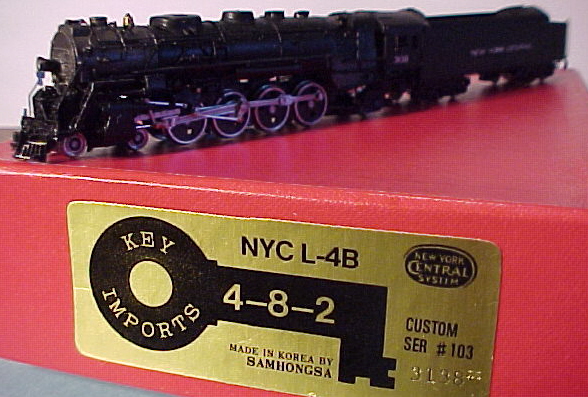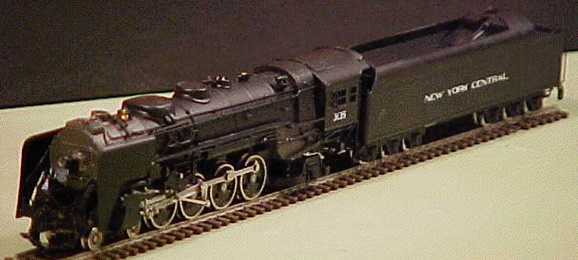

Introduced: 1992
Key's 4-8-2 Mohawk is a gorgeous looking model. And although "as delivered" it has some electrical problems, it does have the potential for being a fine runner (more on that in a moment).

The chassis is all metal, although it's also fairly minimalistic (with the shell providing most of the actual heft). The motor is an open-sided 5-poler. Right-rail pickup is provided by three of the four right-side drivers. Left-rail pickup is provided by the six left-side tender wheels. Current is transferred from the tender to the locomotive via a stiff wire on the drawbar. All the rest of the wheels are electrically neutral. Only the second pair of drivers (from the front) is geared (with the remaining drivers being turned solely by the cranks). The driveshaft is a multi-piece plastic affair, connected to a strange little enclosed worm gear housing. All gearing is metal. The pilot coupler is a dummy (IE, non-operational) knuckle. There is no coupler on the tender (although a pocket and a screw are provided, so adding a Micro-Trains coupler looks to be a simple operation). The shell includes cab interior detailing. The wheels are low-profile, so no problems on Code-55 track. The drawbar has two holes - one for extreme close-coupling. The #3 drivers are equipped with traction tires (an odd choice, since they're not geared). A non-TT driver set is included in the box should you want to trade pulling power for additional pickup. A non-directional headlight is loosely pushed up inside the boiler (with wires running back to the motor). A non-operational (IE, no lightbulb) back-up light is built into the tender.
The actual locomotive mechanism is a good one. And running "wheels-up" on my workbench (with current applied directly to the motor contacts), it's just as smooth and as quiet as can be. However, there is a conductivity issue that needs to be addressed before this locomotive can be considered "operations worthy". The "stiff wire" current transfer scheme on the drawbar is simply not reliable. The wire is affixed to the drawbar fairly loosely, resulting in a lot free play. As a consequence, current conductivity is all over the map. Yes, if you get lucky and wind up with a solid connection when you hook the tender to the drawbar, this steamer will glide around the rails beautifully - smooth, quiet, great throttle response, no pickup problems, etc. Unfortunately, it's all the luck of the draw, and you're just as likely to get an iffy connection (and with the resultant stalls and stuttering one normally associates with bad pickup).
One simple solution to the problem is to apply a glob of solder to the wire where it connects to the drawbar - basically fixing it more firmly in place. A more ambitious fix would be to replace (or augment) the drawbar wire with an actual insulated wire (running from the tender to the motor). Unfortunately, running wires between tender and loco is never pretty. Still, it would definitely provide bulletproof electrical conductivity.
Further detracting from this locomotive's desireability is the fact that it's virtually useless on sharp curves. The drivers on my L-4B derail every time when faced with a 180 degree curve sharper than about 15"-radius.
So overall, a great looking model that (with a bit of tweaking) has the potential to be a very good runner (at least for those with large layouts sporting broad curves). Unfortunately, "as delivered"... not so great.

This model comes with ala carte elephant ears which can be installed by the modeler (see above).
To remove the locomotive shell, unscrew the two small screws on the back (cab) end. Next, unscrew the screw holding the pilot truck to the chassis. The shell should lift up and off the chassis at this point (just be careful pulling the headlight out of the boiler).
Grade: C (as delivered)